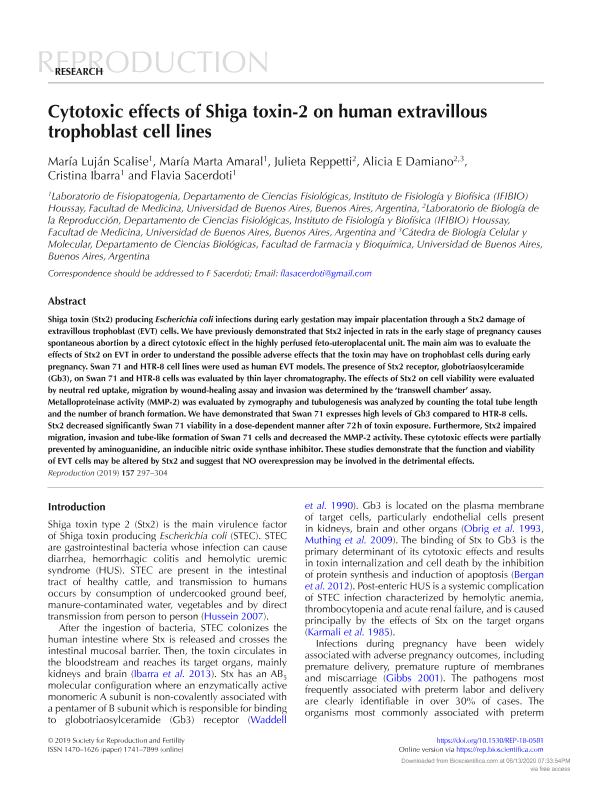Artículo
Cytotoxic effects of Shiga toxin-2 on human extravillous trophoblast cell lines
Scalise, Maria Lujan ; Amaral, María Marta
; Amaral, María Marta ; Reppetti, Julieta
; Reppetti, Julieta ; Damiano, Alicia Ermelinda
; Damiano, Alicia Ermelinda ; Ibarra, Cristina Adriana
; Ibarra, Cristina Adriana ; Sacerdoti, Flavia
; Sacerdoti, Flavia
 ; Amaral, María Marta
; Amaral, María Marta ; Reppetti, Julieta
; Reppetti, Julieta ; Damiano, Alicia Ermelinda
; Damiano, Alicia Ermelinda ; Ibarra, Cristina Adriana
; Ibarra, Cristina Adriana ; Sacerdoti, Flavia
; Sacerdoti, Flavia
Fecha de publicación:
01/2019
Editorial:
BioScientifica
Revista:
Reproduction
ISSN:
1470-1626
Idioma:
Inglés
Tipo de recurso:
Artículo publicado
Clasificación temática:
Resumen
Shiga toxin (Stx2) producing Escherichia coli infections during early gestation may impair placentation through a Stx2 damage of extravillous trophoblast (EVT) cells. We have previously demonstrated that Stx2 injected in rats in the early stage of pregnancy causes spontaneous abortion by a direct cytotoxic effect in the highly perfused feto-uteroplacental unit. The main aim was to evaluate the effects of Stx2 on EVT in order to understand the possible adverse effects that the toxin may have on trophoblast cells during early pregnancy. Swan 71 and HTR-8 cell lines were used as human EVT models. The presence of Stx2 receptor, globotriaosylceramide (Gb3), on Swan 71 and HTR-8 cells was evaluated by thin layer chromatography. The effects of Stx2 on cell viability were evaluated by neutral red uptake, migration by wound-healing assay and invasion was determined by the ‘transwell chamber’ assay. Metalloproteinase activity (MMP-2) was evaluated by zymography and tubulogenesis was analyzed by counting the total tube length and the number of branch formation. We have demonstrated that Swan 71 expresses high levels of Gb3 compared to HTR-8 cells. Stx2 decreased significantly Swan 71 viability in a dose-dependent manner after 72 h of toxin exposure. Furthermore, Stx2 impaired migration, invasion and tube-like formation of Swan 71 cells and decreased the MMP-2 activity. These cytotoxic effects were partially prevented by aminoguanidine, an inducible nitric oxide synthase inhibitor. These studies demonstrate that the function and viability of EVT cells may be altered by Stx2 and suggest that NO overexpression may be involved in the detrimental effects.
Palabras clave:
SHIGA TOXIN
,
EXTRAVILLOUS TROPHOBLAST CELLS
,
MIGRATION
,
INVASION
,
AMINOGUANIDINE
Archivos asociados
Licencia
Identificadores
Colecciones
Articulos(IFIBIO HOUSSAY)
Articulos de INSTITUTO DE FISIOLOGIA Y BIOFISICA BERNARDO HOUSSAY
Articulos de INSTITUTO DE FISIOLOGIA Y BIOFISICA BERNARDO HOUSSAY
Citación
Scalise, Maria Lujan; Amaral, María Marta; Reppetti, Julieta; Damiano, Alicia Ermelinda; Ibarra, Cristina Adriana; et al.; Cytotoxic effects of Shiga toxin-2 on human extravillous trophoblast cell lines; BioScientifica; Reproduction; 157; 3; 1-2019; 297-304
Compartir
Altmétricas



